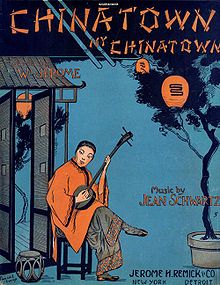Chinatown, My Chinatown
Chinatown, My Chinatown is a pop song written by William Jerome (lyrics) and Jean Schwartz (music) in 1906 and published in 1910. It developed into an evergreen and a jazz standard .
Features of the song
In Chinatown, My Chinatown, Jerome and Schwartz used echoes of Chinese music, which they incorporated into European harmony , especially in the introduction, but also in verse . The piece is inspired by ragtime ; it is structured like a march , but is written in the AB song form and comprises 32 bars .
Reception history
In 1914 the song was used in the revue Up and Down Broadway by WC Fields ; for 1915 the Billboard reports that several vaudeville shows had the piece in their repertoire. Already in the early Dixieland Jazz the piece found numerous interpreters; it has a function as a flag-waver , i.e. H. “As a fast and thrilling opening piece.” Gunther Schuller pointed out the extraordinary speed at which the big bands of the 1930s played Chinatown . John Nesbitt arranged such a recording for the Fletcher Henderson orchestra in 1930. Louis Armstrong interpreted the title in 1931 ; "The grandiose trumpet playing, which climbs to extraordinary heights, includes sustained accompaniment riffs from the orchestra of Luis Russell ." Other outstanding versions are by Lionel Hampton (as China Stomp 1937), Tommy Dorsey , the Casa Loma Orchestra (1934) or Jack Teagarden (1944) . Chinatown was also recorded by Al Jolson and Chris Connor . Other versions are from The Hi-Lo’s ( A Musical Thrill , 2006) and Carl Mann (on LP 14 Unissued Sides .) And John Serry senior for RCA Records (RCA Thesaurus, 1954)
Related songs
Chinatown's musical framework has been used several times as a starting point for other songs; this applies to Louis Armstrong's Struttin 'with Some Barbeque as well as to Space Man by Lionel Hampton and Jess Stacy and to Sax No End by Francy Boland .
Use in film
The song has been used several times in films; first in Max Fleischer 's cartoon of the same name from 1929. In 1987 Woody Allen picked up the song for his Radio Days . It was also used in the video game Mafia by Illusion Softworks in 2002.
literature
- Dietrich Schulz-Köhn : The Evergreen Story: 40 x Jazz Quadriga, Weinheim, Berlin 1990. ISBN 3-88679-188-2
Individual evidence
- ↑ Dietrich Schulz-Köhn: The Evergreen Story , pp. 115–121
- ^ Richard Crawford, Jeffery Magee: Jazz Standards on Record, 1900-1942: A Core Repertory . Chicago: Center for Black Music Research Columbia College 1992, pp. Ix: "Table 1. Jazz Standards in the Core Repertory".
- ^ "Often, these composers chose to use parallel fourths, fifth, octaves, and minor thirds, which had been mentioned in European and American discussions of Chinese music. The most famous example was William Jerome and Jean Schwartz's "Chinatown, My Chinatown" (1910). ”- Krystin R. Moon: Yellowface: Creating The Chinese In American Popular Music And Performance, 1850s-1920s . New Brunswick, NJ: Rutgers University Press, 2005, p. 100:
- ↑ Dietrich Schulz-Köhn: The Evergreen Story , p. 117
- ↑ Dietrich Schulz-Köhn: The Evergreen Story , p. 116
- ↑ See Krystin R. Moon: Yellowface: Creating The Chinese In American Popular Music And Performance, 1850s-1920s . New Brunswick, NJ: Rutgers University Press, 2005, p. 100:
- ↑ Dietrich Schulz-Köhn: The Evergreen Story , pp. 117–119
- ↑ http://www.billboard.com/#/song/al-jolson/chinatown-my-chinatown/4651843
- ↑ http://www.billboard.com/#/song/chris-connor/chinatown-my-chinatown/209361
- ↑ Carl Mann
- ^ Who Is Who in Music International 1958 . Publisher: Who Is Who in Music International, Chicago, Il, USA. Biographical File # B11719 for John Serry. Current publisher: International Biographical Center, Cambridgeshire, UK
- ↑ Dietrich Schulz-Köhn: The Evergreen Story , pp. 117, 119
